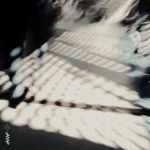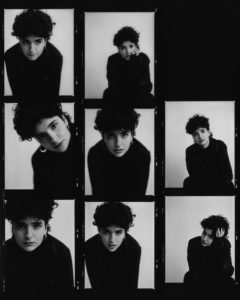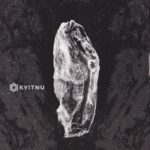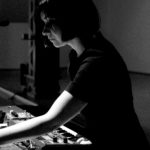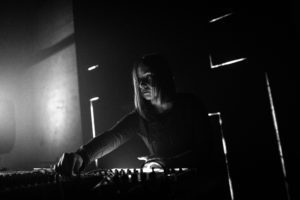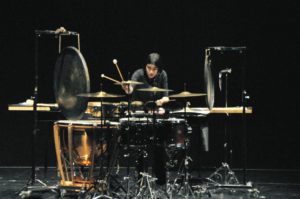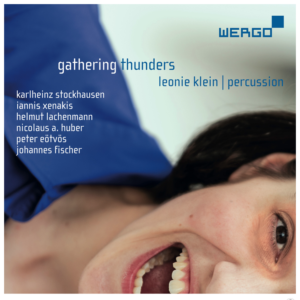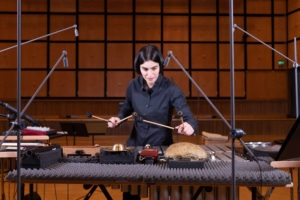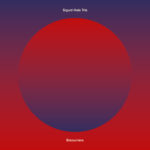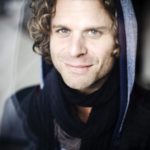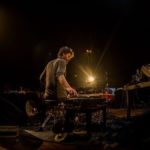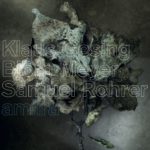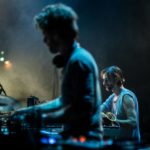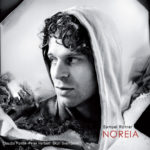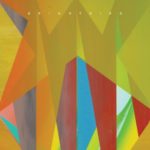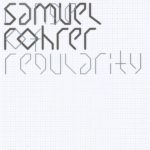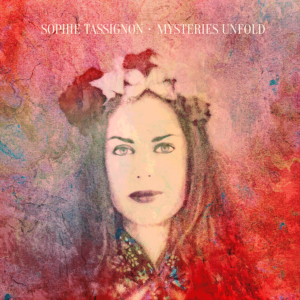
As you know, I’ve written about several RareNoise album releases over the last couple of years. And it’s actually kind of surprising now to find someone like you on the label, isn’t it? How did your album end up there with RareNoiseRecords?
When I was trying to find a label for this record, I looked at a lot of jazz labels and I thought this is not really a typical jazz record, it’s just not going to fit. I kind of had the feeling it won’t fit anywhere. Then I stumbled across RareNoise by accident. I read about what they go for, and I thought, “This is it! This is the label!“ They go for styles of music that don’t really fit anywhere. And then I was very happy when Giacomo [Bruzzo, head of the label] said he really loves it. He’s great to work with, very reliable, positive, and respectful.
So the album was already finished then.
Yes. That was one year ago. I finished the mix on my birthday last year. That was my deadline. And then I thought, “okay, now I can celebrate!“. I went with my gut feeling on this album for every decision, and I’m very happy about how it turned out.
Their description fits with what you do—although the name RareNoise addresses something else.
Totally. I know. This album is really not representative of “noise“ music, but I quite like the label’s name, although it might be a bit misleading for my music. I see the label name as meaning more ‚rare sound‘ which I feel better describes my album. I was not originally familiar with many of the bands on the label, probably because I’m not somebody who checks out a lot of music in general. I always listen to the same stuff over and over.
Such as?
Johnny Cash. Ligeti—but just this one piece on the piano, Fanfares, it’s just fantastic. David Bowie—Ziggy Stardust is my favourite. Some Fado music … It’s very selective. There’s a lot I can’t hear, because it’s too painful—because it’s so beautiful. I spoke with a friend about it because I wondered, “why am I not listening to all these beautiful albums?“ I can’t. Like Jeff Buckley’s album, his only album: For me, it’s just out of space. It’s so deep, emotionally. Or Joni Mitchell, Blue—can’t hear it anymore. I also love the one with Vince Mendoza’s arrangements. I listen to Chopin’s first concerto regularly. And I really love what Bowie did with Donny McCaslin, the final album, it’s really great. I have it on vinyl, but I don’t put it on very often. It’s also so beautiful.
Bowie did a lot of interesting things with his vocals, too. I’ve been listening to a podcast a lot, by a friend of a friend of mine. He invites lots of people to talk about all Bowie albums—one person at a time to talk about one specific Bowie album. And then he puts out the conversations as podcasts. At times they’re rather long, up to three hours, but it’s immensely inspiring to hear these different perspectives and all sorts of different thoughts and background information on this complex body of work, including how Bowie used vocal performance, how he used all those different characters and approaches in each song. I guess you know that he started out working with theatre and performance, and then he used those elements in his stage productions and his recordings throughout his life. So most of his recordings are in a way very close to acting, even though they’re not always about characters, but he performs each song with a specific character and a specific approach to singing. He always puts on a persona. His singing style is very different on all the different tracks and albums. I am fascinated by the way he was using his voice as a unique instrument.
I just bought myself a record of Russian Orthodox choir music. And I find that so beautiful. I went to Russia many times and I used to go to the orthodox church just to listen to the choirs. And sometimes I incorporate that in my music, especially on this album.
I was thinking of something like that, although I couldn’t specify it. You’ve been here in Berlin for about 12 years and done lots of different projects. So would you say that this album is kind of a culmination of your work over the last 10 or 12 years?
Yeah. Thinking about it, I realized that this is really a mixture of all the influences since I was a child. And it’s, in a way, funny to think, “Oh yeah, I put it all in a box. There it is.“ It feels so good when you do something that’s really personal. I just thought, “I want it like this,“ and that’s what mattered most. Of course I am hoping people are going to like it, but it was not made to please someone else. So for me, it’s the first one that’s really true and honest. I think other albums were hiding a certain part of me.
I think I can sense that it’s the result of a long development over years and also a very personal approach, but on the other hand it’s also very simple. Working with loops and different layers, you can always do a whole lot of things. Was it difficult to achieve this simplicity and not include too many elements?
I had a big rule when I started this project: I just wanted to use the voice, I didn’t want to use any MIDI elements or effects. So when I say “voice and electronics,“ there are a few loops here and there that I have worked on, and they’re embedded, they’re not obvious. Nothing has been changed—maybe one note: There’s a very low D in Descending Time, and I think the sound engineer pitched it, or he did something else that makes it sound one octave down. But that would be the only thing that has been changed. All the low notes I recorded at like four o’clock in the morning after a party or something. I would wake up at four or five in the morning and record those low notes, because then they would come out. That was my basic rule and that was also a big constraint. You say there’s a simplicity, but I think this is the most complicated thing I’ve ever done. It’s full of complexity, but of course I hope that no-one hears it. For example, in Cum Dederit, there are 88 different voices that at some point come in and out. So this is really complex, but I’m glad that it sounds simple to you, because there’s nothing worse than listening to music and thinking, “Oh my God, that sounds hard!“
Okay, if we take the song “Jolene,“ it’s almost pop, it’s basically just the tune. Others, like “La Nuit,“ do sound rather complex.
Yes, it’s true. Don’t Be So Shy With Me is fairly simple—and Witches as well.
They are, but I can hear that there was a long process behind them. I also heard these different layers, although I didn’t exactly hear 88 of them. I always admire people who are so versed with working with these loops, using layers of sounds and then singing and playing on top of them. So this must be something you’ve been doing for many years.
Yes, that’s the thing. I think I bought my loop station in 2006, so it’s been, yeah, 14 years! Back then I started building something up with it. You want to do something interesting, not just repetitive. Then in 2009 I was lucky to work with a Japanese dancer just for one short thing, at a tea ceremony in Prenzlauer Berg in a tiny cafe that doesn’t exist anymore. I was doing tons of sound stuff with this loop station. That evening a woman was there, she was curious about how I was doing that and asked for my phone number. And a year later she said, “I need your voice, I need to work with you on a theater project.“ That was Elzbieta Bednarska. I’ve done six theater pieces with her since. And that work inspired me to research and try out a lot of stuff, because you rehearse a lot when you work in the theatre field. On the first piece we did, there was one actress doing a monologue, and I had to do all the music by myself. So I was constantly looking for different things that work so that the audience wouldn’t get bored with just hearing the voice all the time. Working with Elzbieta has always been very inspiring and so much fun. And a lot of that ended up somewhere in here, on this album; for example, the birds in the beginning of Jolene, they’re mixed very softly, because I’m in this little church—I wanted it to be an Orthodox church—and the sound engineer said the birds are outside. That’s why they’re so quiet. Those were inspired from the theatre piece. And the beginning of Descending Tide, that melodic line, was also part of that first piece that I improvised.
La Nuit comes from a longer improvisation I did with Simon Vincent, an electro-acoustic composer I’ve worked with for years in the improvisation project Charlotte & Mr. Stone. It was like a composition within a composition, I took that out and slightly changed it when I listened back to it. I always thought this was a cool melody. Cum Dederit comes from a very different place: I had learned it during my years of classical training, but I never really developed the classical singing. Obviously I got something out of that technique, but I don’t really know how it works. The piece has haunted me for about 20 years, especially with its chromatic development.
Was it a deliberate choice to use all those different languages?
No, because starting with this album, I decided that I wanted to have a project similar to what I do in the theater, but do it alone. It was more like a dare, because in some ways I have a bit of a shy personality. Especially on stage, I’m not always that confident. But when I perform in theatre I feel much more confident and people like it a lot. So I planned to make myself one set and to perform it on my birthday six months later or something like that. Then I thought, as it’s going to be my birthday, I’m going to choose all the songs that I want to do just for myself—as my own birthday present. I chose only songs that for some reason really touched me. That explains why the selection is very unique. It was very complex to record this on my own. I had always dreaded that because I’m not so good with software and all that.
So these are all songs you had performed a lot in your shows?
Yes. It was so nice that often after my solo concerts people came up asking for a CD and said, “I want to take that home with me.“ And I replied, “But I don’t have a CD.“ They suggested, “You could simply record what you just did live.“ And I thought, no, it’s not going to be the same. It’s not going to sound like what you hear because you’re in that specific room. You don’t actually hear the little mistakes and the loops that are glitching, the pops, you know. So when I started to work on the album I had to redo 90% of the loops that I had created over time. I had to deconstruct, transcribe and rerecord everything using a different microphone. It took me about a hundred hours per song to recreate what I was doing live.
Wow. It does sound very meticulous. One can hear the long process, but it’s not overpowering. It’s obviously not just like you went in front of a microphone and did some singing.
In 2015 I learned Ableton Live, so I could do a lot of more complex things that I prerecorded and prepared. There are some textures, for example in La Nuit, which I could create with higher notes. I would record one note and then I would copy that note and place it slightly underneath but in a different track. And then that would be looped. So it would sound like one long thing. Or I would just record the same note five times and place them next to each other. So I would have one note and then I would do that with another one and another one. And I would record those notes louder and softer so that I can create this moving texture with these long notes. That was super fun. So then I had that texture, which I could bring in and out whenever I wanted to.
So basically you knew what kind of sound you needed. And then it was a lot of work constructing the different layers.
Exactly. Mysteries Unfold is actually one that I composed a while back, in 2015. I composed it on the piano. I had the chords and the melody, and I took that with me when I went to the International Centre for Composers in Visby (VICC). First I recorded the A section; I wanted some melodic lines that create harmony and sort of develop the melody. And the second part was a total experiment. I just cut some notes short and placed them in a way that it created some sort of rhythm.
When you choose these songs from different origins and in different languages, is the content of the lyrics important to you? The first song, “Gubi Okayannie,“ for example, I guess many people won’t understand anything you sing there, as it’s in Russian. And even more so the song in Latin. And there are other parts on the album where the voice is not even conveying lyrics but turns into something abstract, it’s not just a song anymore. “Jolene“ works almost like a story, whereas others don’t.
Actually, whenever I listened to songs, I never used to pay attention to lyrics. I still don’t really. My ear is not drawn to words but to the harmony and the melody and the sound. For me lyrics don’t really matter. Gubi Okayannie has touched me particularly, because I saw it in a movie and I transcribed it from the video because I wanted to sing it. I love the film, Five Evenings by Nikita Mikhalkov. There’s this guy who takes out his guitar and sings this song, super gently. It’s beautiful. But of course when I took it, I just couldn’t do it in a similar way. I’m not him and it’s so beautiful the way he does it, so why should I try to do it like him?
But that’s true for all the songs. “Jolene“ is a song that many people have heard. When I heard your recording of “Witches“ it sounded very familiar, I had to check where it’s from, but I don’t think I actually ever heard the [Cowboy Junkies] original. Your whole approach is a very personal one. You’re using these songs to turn them into something personal, even though they might be familiar in another context or in a film. A Dolly Parton audience might also be a different audience from those who buy RareNoise records.
Yeah, frankly, I must say I didn’t know Dolly Parton and I didn’t even check out her version until a few years ago. I started singing it in 2009 with a band I had with three other singers and we would write arrangements. And I absolutely loved these lyrics, they were just so amazing. So I decided to sing just the lyrics, because they’re so powerful. And for me, this song was always a slow one, and now I made it even slower than it was before, by doing it a cappella with no time. When I heard the original, I was like, “Wow!“ I didn’t even know she was so famous and that song was so famous. And Witches, too; actually, I don’t think I’ve ever heard the original.
I really like this idea of taking something from either a different culture or another genre, like country music, and turn it into something very different, like Orthodox choir music. That’s what people like Johnny Cash and or, at times, David Bowie have done, too.
Now with Jolene, when I used to sing it, a lot of people said they cried, as it was just one voice singing these lyrics that are so powerful, so sensitive. I love that. But when I recorded it at home, I thought that’s not going to work. Something was missing. It’s an album. It’s not a live performance. You can’t just do what you do on stage and put it on a CD as it is. Then these chords came to me, like Orthodox church kind of chords, I wanted to have this kind of holiness. But then the question was, how much of it? You know, I could write a huge arrangement with more voices and all that, but I still wanted it to be pure. So that’s why the beginning is still with nothing but the birds, and then these chords come in.
One final question: What’s the story behind that painting on the album cover?
The Cover was designed by ROK, an artist living in Budapest. I really loved what he did for previous albums on RareNoise so I was very happy to work with him. I suggested Fernand Khnoppf as he’s one of my favourite artists. He’s Belgian which is a coincidence! So ROK decided to use a photo of me taken by Peter Van Huffel and did an amazing job reworking it joining the idea of Khnoppf’s mysterious painting style to the different layers and deapth of the album.
The conversation between Sophie Tassignon and IJ.Biermann, recorded in Berlin, April 2020, has been edited and condensed for clarity. more… »
